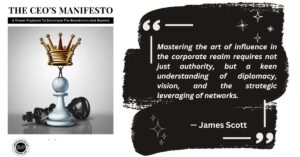C-Suite Influence — Navigating the upper tiers of a corporate structure requires more than sheer will or lofty title; it necessitates a nuanced comprehension of influence, its inner workings, and its driving forces. In the high-stakes theatre of the C-Suite, understanding these dynamics is not optional; it is a cardinal prerequisite for those who seek to assert their influence and exercise effective leadership.
To elucidate the nature of influence, let us visualize it as a grand edifice, a majestic monument supported by four robust pillars – credibility, expertise, access, and diplomacy. These pillars, individually and collectively, underpin the formidable structure of influence. They act as a guide, shedding light on the pathways through which power can be effectively wielded within an organization.
Related Articles:
- DeFi: Democratizing Finance and Banking the Unbanked in Southeast Asia
- Enhancing Food Safety Measures through Blockchain: From Farm to Fork
- Revolutionizing Energy Grids: The Role of Blockchain in Microgrid Management
Let us begin our in-depth examination with the first pillar: credibility. The cornerstone of effective leadership, credibility stems from an executive’s personal integrity and reliability. Like a well-crafted statue sculpted over time, credibility is not bestowed overnight. It is the result of consistent actions that reflect unwavering adherence to principles and a firm commitment to fulfill promises. In the grand theatre of the C-Suite Influence, where each actor seeks to promote their agenda, a leader with a reputation for consistency and honesty commands respect, which in turn amplifies their influence. Every act of reliable judgment, every promise kept, and every expectation met, contributes to the establishment of trust – a formidable currency in the world of power and influence.
Then comes the second pillar: expertise. It is the torch that illuminates the path ahead in the often murky landscape of corporate decision-making. Expertise is rooted in a deep-seated understanding of the industry, business fundamentals, and the enterprise’s operational dynamics. It equips executives with the lens to discern patterns, anticipate market trends, and identify opportunities amid uncertainty. An executive armed with expertise can guide the organization through uncharted territories, uncovering potential advantages and mitigating looming threats. The validity of their influence relies significantly on the depth and breadth of their knowledge, their analytical prowess, and their acuity in decision-making.
The third pillar, access, reflects the executive’s connectedness within and beyond the organization. It offers them the ability to tap into the pulse of diverse business units, stakeholder groups, and even competitors. Those with broad access enjoy a panoramic view of the organizational landscape, enabling them to gather multiple perspectives, anticipate reactions, and build broad-based coalitions. It aids in formulating strategies that take into account a multitude of factors, rendering their influence more impactful and far-reaching.
Get Free eBook About The CEO’s Manifesto
The fourth and final pillar, diplomacy, is an art in itself. This involves the judicious use of interpersonal skills to manage relationships and align divergent interests towards a common goal. A diplomat executive can mediate disputes, foster consensus, and enhance cooperation among various stakeholders. They know when to press forward, when to compromise, and when to step back, resulting in a more harmonious and productive decision-making environment.
These pillars do not operate in silos. They are interconnected, with each strengthening the others. The credibility of an executive bolsters the weight of their expertise, while their access extends further when reinforced by credibility and expertise. Diplomacy, built on the foundations of the other three pillars, fine-tunes the influence of an executive, making it more agreeable and effective.
Central to all these is the CEO. As the chief decision-maker, they have the power to leverage these pillars to align interests, drive strategic initiatives, and balance the intricate power dynamics within the C-Suite. Each pillar enhances their influence in distinct ways. Without credibility, an executive’s expertise might be doubted. If an executive lacks expertise, their credibility might appear hollow. Without access, the reach of credibility and expertise remains constrained. And without diplomacy, even the strongest credibility, profound expertise, and widest access may fail to translate into influence.
Pros and Cons About The Pillars of Power | C-Suite Influence
Learning the possible advantage and disadvantages of this chapter, and how credibility, expertise, access, and diplomacy shape executive leadership dynamics.
Pros:
- Credibility fosters trust and respect, laying the foundation for effective leadership.
- Expertise enables executives to make informed decisions and anticipate market trends.
- Access provides a panoramic view of organizational dynamics, facilitating broad-based coalitions.
- Diplomacy enhances cooperation and consensus-building, fostering a productive decision-making environment.
- Strategic application of these pillars empowers executives to steer organizational direction and drive success.
Cons:
- Building credibility requires consistent integrity and reliability, which can be challenging to maintain.
- Developing expertise demands continuous learning and adaptation to evolving business landscapes.
- Gaining access to diverse perspectives may encounter resistance or organizational barriers.
- Practicing diplomacy requires adept interpersonal skills and may face obstacles in managing conflicting interests.
- Balancing these pillars effectively necessitates strategic finesse and may involve navigating complex power dynamics within the C-Suite.
Thus, it is the strategic application of these pillars that empowers an executive to extend their influence effectively within the C-Suite. Understanding and mastering these elements can transform the executive’s role from being a mere participant in the decision-making process to a pivotal player who can steer the organization’s direction.
In the subtle ballet of power that is the lifeblood of the C-Suite, every move, every word, and every decision carries weight. It is not an overt show of authority that determines an executive’s sway over the C-Suite but the deft maneuvering of these pillars of power. It is within this intricate interplay of credibility, expertise, access, and diplomacy that an executive’s influence truly reigns, guiding the organization’s course towards success and sustainability.
Frequently Asked Questions About C-Suite Influence
Get insights into mastering influence in the C-Suite with these commonly asked questions and expert answers.
What role does credibility play in executive influence?
Credibility is paramount in the C-Suite, establishing trust and respect. It’s earned through consistent integrity and reliability, forming the bedrock of effective leadership.
Why is expertise crucial for executives?
Expertise provides executives with the insight to navigate complex business landscapes. It allows them to anticipate trends, identify opportunities, and make informed decisions.
How does access contribute to executive influence?
Access empowers executives to gather diverse perspectives, anticipate reactions, and build coalitions. It broadens their understanding and strengthens their strategic influence.
What is the significance of diplomacy in the C-Suite?
Diplomacy fosters cooperation, mediates disputes, and aligns interests toward common goals. It’s essential for navigating complex relationships and driving consensus.
How do these pillars intersect to enhance executive influence?
The four pillars of power—credibility, expertise, access, and diplomacy—are interconnected, reinforcing each other to amplify executive influence within the C-Suite.
In the realm of the C-Suite Influence it is not merely about authority but about the strategic orchestration of credibility, expertise, access, and diplomacy. Executives who master these pillars wield profound influence, guiding organizations towards success amidst the intricate dynamics of corporate leadership. By understanding and strategically applying these elements, executives can elevate their roles from mere participants to pivotal players, shaping the trajectory of their organizations with wisdom, integrity, and foresight.



